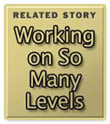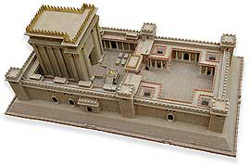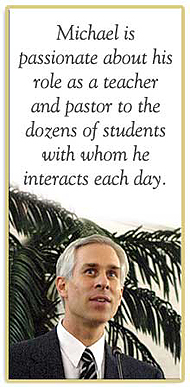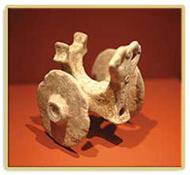BY BILL KNOTT
 HERE ARE MANY WAYS TO BEGIN THIS story, each of them valid,
each of them true. Any story of importance has several possible starting points,
depending on how far back in time you want to go to find the right moment.
HERE ARE MANY WAYS TO BEGIN THIS story, each of them valid,
each of them true. Any story of importance has several possible starting points,
depending on how far back in time you want to go to find the right moment.
Some would say that this story begins with an Adventist scholar
named Lynn Harper Wood, president more than 80 years ago of what is now Southern
Adventist University. His 1937 Ph.D. in archaeology and his subsequent establishment
of the first program in archaeology at the Adventist Church's new seminary laid
the foundation for decades of research, teaching, and publication.
Others would say that this story begins with a faithful German
Adventist family reconstructing their lives in the aftermath of World War II.
Their loyalty to principle, the obvious enjoyment they found in learning, and
their commitment to serving the church they loved have touched thousands of
Adventist lives through three generations.
Some might even trace the tale much further back, to when an
unknown Hebrew woman lifted a new-made water jug up to examine the excellence
of the potter's craft before she filled it the first time. Three thousand years
later, we wonder if her fingerprints are still upon the vessel that rests so
lightly in the museum display case.
 Begin the story where you will, you must not miss the Friday
night tradition in which a world-traveling Old Testament scholar regularly took
the time to show his family slides of all his journeys. The dark-haired boy
who leaned against the sofa, drinking in his father's images of Palestine, ancient
Babylon, Jordan, and Egypt, found his imagination fired and his heart stirred.
The world of the Bible, glimpsed in Sabbath school songs and stories, took on
tangibility, substance, and perspective. Seeing such things, interpreting these
things, would be the tale of his life.
Begin the story where you will, you must not miss the Friday
night tradition in which a world-traveling Old Testament scholar regularly took
the time to show his family slides of all his journeys. The dark-haired boy
who leaned against the sofa, drinking in his father's images of Palestine, ancient
Babylon, Jordan, and Egypt, found his imagination fired and his heart stirred.
The world of the Bible, glimpsed in Sabbath school songs and stories, took on
tangibility, substance, and perspective. Seeing such things, interpreting these
things, would be the tale of his life.
The intersection of these varied stories occurred on a warm
and misty Thursday evening in November as dozens of donors, academics, and invited
guests gathered on the campus of Southern Adventist University for a remarkable
event. Five years of planning, months of heavy construction labor, and the generosity
of friends who believe in biblical scholarship came to a climax with a celebratory
dinner and ribbon cutting for the new Lynn H. Wood Archaeological Museum, one
of only three Adventist archaeological collections in North America, and one
of the finest exhibits of any kind the church has ever produced (see "Working
on So Many Levels,"
p. 12).
The unique Middle Eastern menu of the dinner, the gracious
words from university administrators and invited guests--even the rain that
fell lightly over the Collegedale hills--could not mask the realization that
all these things had coalesced because of the energy and faith of one gifted
man. Thirty-six-year-old professor Michael Hasel, director of the university's
Institute of Archaeology and curator of the new museum, modestly pointed to
the contributions of patrons and academic colleagues, but all in attendance
knew that little of what they saw and experienced would have happened without
his efforts.
Hasel, who holds a Ph.D. in archaeology from the University
of Arizona and has taught at Southern Adventist University since 1998, will
have even more opportunities in the near future to practice being modest. In
the summer of 2004 he received word that he had been awarded a Fulbright Scholar
grant for the 2004-2005 academic year, placing him among only a handful of Adventist
academics who have received the prestigious research grants from the United
States government for international scholarship. The competitive Fulbright Scholarship
Award program selects recipients on the basis of academic or professional achievement,
and focuses on those who have demonstrated leadership in their chosen fields.
More than 160 countries participate in the collaborative scholarly program.
The Fulbright award will allow Hasel, his wife, Giselle, and
their two daughters, 6 and 4, to spend seven months in Cyprus at the Cyprus
American Archaeological Research Institute (CAARI) from January through August
2005. He will be researching and writing a volume that focuses on the worldview
of the ancient Egyptians as reflected in the place names they used for other
countries and ethnic groups around the Mediterranean basin in what would today
be Israel, Syria, Jordan, Cyprus, and Turkey. The project will call upon his
training in both Egyptology and Syro-Palestinian archaeology, allowing an interdisciplinary
look at materials that interface with the biblical record.
 "The effects of postmodernist scholarship on the general
public's belief in the historicity of Scripture during the past 20 years have
been devastating," Hasel notes. "Many modern scholars are now producing
volumes flatly stating that we can have no confidence that the events described
in the Old Testament actually occurred-that all that we read in the biblical
record from the patriarchs through the exile in Babylon is a brilliant and pious
fraud. And many people are simply accepting those claims because they don't
have access to better information.
"The effects of postmodernist scholarship on the general
public's belief in the historicity of Scripture during the past 20 years have
been devastating," Hasel notes. "Many modern scholars are now producing
volumes flatly stating that we can have no confidence that the events described
in the Old Testament actually occurred-that all that we read in the biblical
record from the patriarchs through the exile in Babylon is a brilliant and pious
fraud. And many people are simply accepting those claims because they don't
have access to better information.
"By looking at actual place names and studying the historical
underpinnings obtained through objective research in archaeology, I'm hoping
that my work can provide assurance that we do have a reliable record in the
biblical story."
The Practical Value of Scholarship
Hasel is insistent that biblical scholarship of the kind he is engaged in must
prove itself useful to the wider Adventist and Christian publics as well as
to students in classrooms. "If scholars just live in the ivory tower, we're
isolating ourselves from our true mission, not only as scholars, but as Christians,"
he admonishes. "It's important for us to make the things we study applicable
to the general public.
"For most of us who have grown up in the Adventist Church,
we've read these Bible stories again and again, and we think we know them--and
we do, to a certain extent. But archaeology provides such a new and unique dimension,
especially in the contemporary world where we want to touch and feel and taste
everything. It just brings it to life."
Hasel found that the biblical world came vividly alive to him
as a child and teenager through the stories and slides his father shared with
the family. Gerhard Hasel, longtime professor of Old Testament at the Seventh-day
Adventist Theological Seminary at Andrews University, was a much-published scholar
of international reputation, and served as dean of the seminary from 1981 to
1988. Michael credits his father's interest in the Old Testament and the trip
he shared with his dad to the Middle East as a teenager with sparking his own
interest in what he is doing today.
The younger Hasel also felt an enduring call to ministry rising
in his life during his teen years in Berrien Springs, fanned by significant
conversations with his pastor-grandfather in Germany. He held the two possible
career tracks--archaeology and pastoral ministry--in tension through his college
experience, during which he completed a bachelor's degree in theology and worked
as a volunteer in the university's archaeology museum. Several summers were
spent on archaeological digs in Palestine, and Michael was a frequent attendee
at specialized lectures occurring on the university campus.
In the summer of 1990, a month spent colporteuring in the New
Jersey Conference introduced him to his future wife, Giselle. Though they had
both been studying at Andrews University for several years, they had never met.
Their courtship stretched over the next two years as she finished a degree in
illustration and graphic design and he prepared for a future that he hoped would
include both pastoral ministry and scholarship.
A Fruitful Relationship
That same summer Michael also spent a month excavating in Israel at the site
of ancient Gezer under the direction of William Dever, then the most prominent
American archaeologist working in the Middle East and director of a prestigious
academic program in Near Eastern archaeology at the University of Arizona. After
he and Giselle were married in 1992, Michael enrolled in Dever's program, and
quickly forged a bond with a man at the center of much scholarly debate about
biblical archaeology.
 Though Dever shared few of Hasel's religious commitments, he
earned Michael's admiration for his openness, his honesty, and the respect he
showed for Michael's faith.
Though Dever shared few of Hasel's religious commitments, he
earned Michael's admiration for his openness, his honesty, and the respect he
showed for Michael's faith.
"I remember him saying right after I arrived in Arizona, 'You know, Michael,
I know what background you come from, and I've known your father for many years
and have read his books. I just want to let you know that I don't care what
you think or how you position yourself theologically, as long as you do good
archaeology; that's what's going to count in this program.'"
"I've always respected Dr. Dever as a scholar, as an archaeologist,
and as a friend," Michael adds. "It's been a good relationship over
the years."
The value of that enduring friendship became apparent to the
Southern Adventist University community in January 2000, when Dever placed more
than 200 ancient art pieces and objects on the campus under the promise that
they would one day be housed in a museum there. Establishing an archaeological
museum on the campus had long been the dream of the dean of the School of Religion,
Jack Blanco. Hasel's personal and professional relationship with the eminent
scholar provided the occasion.
The remarkable collection of complete sequences of juglets,
jars, lamps, and bowls as well as stone and metal objects is displayed in the
new museum to introduce visitors to the lands and life of ancient Egypt, Babylonia,
Persia, Syria-Palestine, Greece, and Anatolia. Experts consider the Dever contribution
to the new Lynn H. Wood Archaeological Museum to be one of the finest collections
of Near Eastern antiquities in North America.
"Museums--at least good ones--are built around a respect
for the real thing, real artifacts," Hasel adds with a smile. "Replicas
or even pictures won't do: you have to be able to display the actual items that
illustrate how life was lived in the ancient world. The items from the Dever
collection are exhibited in a visually stunning display, and they're accompanied
by more than 200 photographs, paintings, and maps that focus each case on a
different aspect of life in the ancient world."
A Focus on Faith
As excited as he clearly is about the opening of the new museum and the impressive
collection it houses, Michael is even more passionate about his role as a teacher
and pastor to the dozens of students with whom he interacts each day in his
classroom and office. He credits the years he spent pastoring two congregations
near Detroit, Michigan, between the completion of his Ph.D. and his employment
at Southern Adventist University with sharpening his skills as a listener and
guide to students.
"I often say that being a pastor is the highest calling
anyone can have," Hasel says solemnly. "All of us here who teach in
the School of Religion function in that capacity as well, as we counsel with
students and work with them. It may mean talking with them about faith issues,
baptizing them when they've made a commitment to faith, or even marrying a couple
you've had in classes through the years. Those are all important elements that
we're involved with."
 "I've had the privilege of attending his Old Testament
class," says Rita Vital, an Adventist retiree in Collegedale who used to
direct the church's health ministry van outreach in Boston. "I've gotten
such a blessing out of his classes that I asked him if I could invite some non-Adventist
friends--and they're loving it too!"
"I've had the privilege of attending his Old Testament
class," says Rita Vital, an Adventist retiree in Collegedale who used to
direct the church's health ministry van outreach in Boston. "I've gotten
such a blessing out of his classes that I asked him if I could invite some non-Adventist
friends--and they're loving it too!"
"He's the reason I've decided to refocus my career plans,"
murmurs one admiring student who helped to guide the guests through the new
museum on the opening night. "He's a first-rate scholar, respected by people
in his profession. He's got the gift of making learning accessible and fun and
inspiring all at once. And he's clearly a godly man."
Hasel himself blushes to hear such things, waving away the compliments. "It
has really been amazing to see the level of commitment the students in this
program bring," he notes, pointing to the seven graduates and 25 students
enrolled in the university's bachelor degree program in archaeology. "Last
summer, when we were excavating at Hazor (a prominent biblical site in northern
Israel), I was so impressed by their performance and their attitude, as were
the Hebrew University professors who were running the excavation.
"To me, that speaks for the success of what we're trying
to do here," he says. "If the students are excelling and doing well,
that matters more than the museum or the professors. We've been fortunate to
get a good group of young people here, and not just in archaeology. It's encouraging
to me to see these students so eager about faith, so eager about Scripture,
so eager to show the world the evidence that undergirds what we believe."
"A man's pride will bring him low, but the humble in spirit
will retain honor,"* says the proverb. So long as persons like Michael
Hasel continue to invest in Adventist higher education, neither they nor their
students will lack for honor, both here and above.
_________________________
*Prov. 29:23, NKJV.
_________________________
Bill Knott is an associate editor of the Adventist Review.


